Have you installed your greenhouse and are now wondering how in the world to go about starting a greenhouse garden? Are you just curious and looking for a beginner’s guide to greenhouse gardening? Then we got you covered! In this comprehensive guide, you will discover not only how to create the right greenhouse conditions for your plants, but also which plants you should start with.
We understand that starting a greenhouse garden can feel overwhelming, even if you’re an experienced gardener. Although you may be excited to grow a wide variety of plants in your greenhouse, we recommend starting small so you set yourself up for success. Don’t worry, we’ll assist you along the way!
To ensure that you have fun growing in your new greenhouse, it’s important to consider not only what you want to grow, but also what greenhouse conditions are necessary for optimal growth. This includes factors such as temperature, soil, moisture, and light. Let’s dig into these more below.
Easy plants for greenhouse growing
Whether you are a novice gardener or expert gardener dipping their toes into greenhouse gardening for the first time, our recommendation is the same: start with plants that are easy to grow. This is so that you can learn the ins and outs of the greenhouse environment, which differs significantly from the outdoor garden. Once you have a good grasp of greenhouse gardening, you can consider growing more exotic or tropical plants, too.
Here are 10 plants that are sure to bring you a bountiful harvest in your first season with a greenhouse:
- Radishes
- Peas
- Strawberries
- Garlic
- Leafy greens such as lettuce or kale
- Tomatoes
- Leeks
- Potatoes
- Zucchini
- Cucumbers
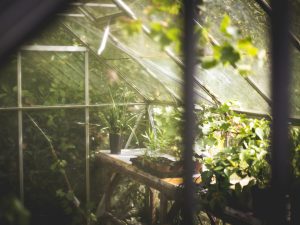
The Essentials for Beginners – Greenhouse Gardening 101
remember: take it one step at a time, and you’ll be sure to succeed!
1. Starting seeds
The controlled environment of a greenhouse is ideal for extending the growing season. In some climates, or with extra heating or cooling, you may even be able to grow all year round! But in all cases, you’ll want to know how to start plants from seed; this will not only save you money in the long run, but it will result in stronger, more resilient plants.
When starting your own seeds, keep the following in mind:
- Be seed smart: understand the different seed labels and how they affect the quality of the seeds.
- Make a list of what you want to plant, and where.
- Invest in proper seed-starting containers such as seed trays, hydroponic trays, or single plug trays.
- Get sterile soil to prevent plant diseases and pest infestation.
- Be ready to feed young plants with properly diluted fertilizer or plant food.
- Always water your plants as recommended for each individual plant.
- Even though you can climate control your greenhouse to an extent, ensure that your local climate is conducive to the plants you want to grow.
- Evaluate how much sunlight is entering your greenhouse vs. how much light your plants need: will your plants need grow lights?
Make sure to inspect the seed packets closely; they will give you a lot of important information such as germination rate, which will help you determine how many seeds you should sow to get your desired number of plants. As a rule of thumb, it is better to overseed and choose the strongest plants for your garden than to have only a few plants make it to the transplanting phase.
Make sure to check out our favorite organic seeds here!

2. Temperature control
Another lesson in greenhouse gardening for beginners revolves around temperature control. You already have a head start with controlling the temperature of your garden by just using a greenhouse. However, to further extend the seasons, you could consider getting an electric or gas heater to grow well into the colder months or an Evaporative Cooling System to make it through the warmer months (or both for the ultimate year-round growing experience).
In the summer months, cooling is an important part of keeping greenhouse plants alive. Your first instinct should be to ensure that your greenhouse is properly ventilated by opening windows or vents in the morning before it gets too hot. Greenhouse fans can also be effective at keeping the temperatures inside a greenhouse cool. However, the most effective method is evaporative cooling, which not only helps regulate temperature but also the humidity inside a greenhouse. It works wonders for hot and dry climates such as in Arizona, Colorado, and California.
By contrast, a heat source may be necessary if you live in a cold climate. Although there are plenty of ways to heat a greenhouse without electricity, sometimes an electric or gas heater is necessary to sustain the desired temperature in your greenhouse. A programmable heater with automated timers is particularly helpful to take care of unexpected temperature drops without risking overheating. Gardening experts also advise using heaters for propagating seeds in cold weather. You can even opt for propagating heating mats to further cut down on your energy bills.
Learn more about the best greenhouse heaters here!
3. Light
Plants need light to photosynthesize, the process by which they turn carbon dioxide and water into glucose and oxygen. In other words, light is plant food! Fortunately, greenhouses are designed specifically to maximize the amount of light that reaches your plants’ leaves for maximum plant growth.
However, there may be times when it is necessary to increase the amount of light that your plants receive, for example during the early spring when you are starting many of your plants but the days are still quite short. The only way to generate more light in a greenhouse (short of trimming any overhanging tree limbs that are blocking out the sunlight) is to install grow lights.
But not all grow lights are the same. To choose the grow lights that are best for your needs, you should think about the types of plants you are growing and how much direct or indirect light they need to thrive.
Types of grow lights
Plants react in a different manner to the intensity and span of light. As plants develop and grow the number of leaves, the demand for light increases. Most of the light utilized by plants is in the noticeable light spectrum. Red and blue colored light are the wavelengths of light most widely used in photosynthesis. They are ingredients of white light or sunshine. Numerous man-made light sources have diverse color blends that may or may not suffice the photosynthetic requirements of your plants.
LED grow lights and fluorescent lamp strips are high-output lighting products that will serve you well in this regard. They are a crucial element to photosynthesis. They are particularly effective because they will cover a larger surface area and output the full spectrum of light your crops require.
Learn more about picking the right grow light here.
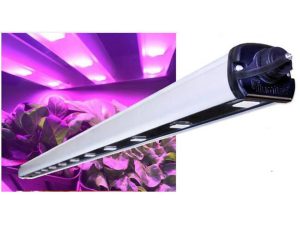
4. Watering
There are many different watering systems and techniques that you can use to keep your greenhouse plants hydrated. And while you can find numerous ways to make regular watering a simple, automated process, it’s important to bear in mind the water requirements of particular plants, as some require more water than others. Instead of watering all of your crops equally, learn what is required to ensure you do not over or under-water them.
Signs of inappropriate watering include irregular drying in the soil, decreased plant growth, root rot, or the presence of mold, pests, or fungus. Unfortunately, incorrect watering not only weakens plants, but it can also make them more vulnerable to pests and diseases such as powdery mildew, which may then lead you to resorting to pesticides or herbicides.
The most important thing to keep in mind is that not every plant wants the same volume or frequency of water. Overwatering doesn’t necessarily happen when your plant is given huge amounts of water at a time, rather, it occurs when the soil is not allowed to properly drain between waterings. To avoid this problem, you can install a drip system to provide plants with a regular and steady supply of water. You can easily automate this kind of watering system with a timer and drip gauge.
On the other hand, underwatering can occur when the soil dries out too much between waterings. Raised planter beds and plant pots are particularly susceptible to underwatering, as they drain faster and have a tendency to dry out. Prevent underwatering by frequently checking the soil moisture and watering deeply when you do water. Remember that it is the roots that require access to water, not the leaves. Spraying the plant canopy may seem effective, but it is a misuse of water and actually increases the likelihood of disease, especially if there is not enough proper ventilation in the greenhouse.
Read more about greenhouse irrigation methods here!

5. Accessories
There are many accessories that can make greenhouse gardening a lot easier for you. Depending on your budget and commitment, you may choose to keep it simple and only get the bare necessities, or you may choose to go all out. Some of the most useful greenhouse accessories include: mist systems, fans, shelving, potting benches, digital thermometers/hygrometers, space heaters, grow lights, shade cloths, among others!
Things to keep in mind while shopping for these accessories include what your plants need, what you would like to have, and the amount of space your greenhouse provides. For example, some plants benefit from the slow, deep watering provided by a drip irrigation system, while others can handle general watering techniques with no adverse effects on their growth. Similarly, if you’re not planning to grow during the winter months right away, you may not need to invest in a space heater or grow light setup.
Here are some popular choices of greenhouse accessories and their benefits:
- A misting system can help maintain humidity levels inside the greenhouse environment, which is especially crucial in warm or dry climates.
- Shelves and racks are the best way to save space and keep things organized in a small greenhouse.
- Greenhouse fans serve multiple purposes: they help with bug and pest problems by maintaining good airflow and ventilation and they assist in purifying and even cooling your greenhouse, especially when matched with a suitable ventilation system.
- A simple digital thermometer/hygrometer may be a tiny accessory, yet it is one of the most critical when it comes to greenhouse gardening. A thermometer helps you keep track of temperature inside your greenhouse, while a hygrometer indicates humidity. Knowing temperature and humidity levels in your greenhouse helps you make the right corrections in a timely manner.
- While lots of natural light is usually beneficial to plant growth, there are times that too much light can be damaging to plants, especially young or tender plants. When this is the case, you can easily install shade cloths to reduce the amount of light getting in.
Pest control for the beginning greenhouse gardener
Unfortunately, just as a greenhouse is beneficial for plants, it’s also an ideal environment for pests that manage to find their way inside. The warm, humid environment and plentiful plants in a greenhouse constitute an attractive habitat for pests.
In order to manage pests in your greenhouse, it’s important to be vigilant and deal with any pests you find before the issue gets out of hand and you lose entire plants to an infestation.
These are the top pests to look out for:
Aphids: These delicately colored, soft-bodied insects love to live on the undersides of plant leaves. Make sure to check these spots regularly, and take action accordingly when you find evidence of aphids. If there are just some aphids, you can spray the aphids off with a garden hose. In more serious cases, it’s best to prune any affected leaves.
Thrips: Thrips vary in color from brownish to black. Thrips may leave damage extending from moderate to critical. You may stop these invasions by using screens on vents, examining new supply entering your greenhouse and regulating weeds will help to control thrips.
Bloodworms: These elongated, roundworms are comparable to fungus gnat larvae in lacking limbs and having a well-defined brown head. The red color is because of the appearance of hemoglobin, just like in human blood. The existence of hemoglobin lets them grow in water with extremely low oxygen content.
Slugs and snails: You may find more slugs and snails when humidity is high. These are nocturnal, fleshy, and slimy creatures. Cleanliness is necessary for slug and snail control. make sure your greenhouse is free of plant wastes like uprooted weeds, leaves, used boards, bricks or rocks that provide cool and moist hiding spots.
You can find all our organic pest control posts here!
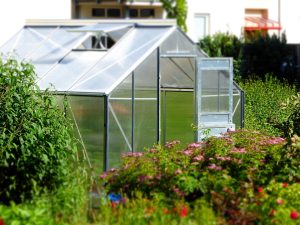
Common greenhouse gardening mistakes
Growing plants in a greenhouse can be a really rewarding process, but it’s inevitable that you’ll make some mistakes along the way. We’ve identified some of the most common beginner mistakes so you can take steps to avoid them:
Temperature
One of the significant mistakes inexperienced gardeners make is failing to observe greenhouse temperature on a regular basis. The easiest way to keep track of greenhouse temperature is with a basic thermometer or digital thermometer/hygrometer that also keeps track of humidity.
Humidity
Too much humidity may let mold, mildew, and pests run rampant in your greenhouse. On the other hand, too little humidity will make your plants die of thirst. Misting is the best approach to improve humidity.
Ventilation
If your greenhouse has limited or no ventilation, your plants may die of overheating. You can open windows and roof vents to release hot air, but in warmer weather a fan may be required to maintain sufficient air circulation.
Soil
Healthy, well-drained soil is crucial to a greenhouse garden, but it poses some challenges. First, selecting a soil type is important. While it may seem easy to simply use your native soil, it’s important to make sure you’re not introducing pests into the greenhouse. Additionally, make sure to add organic matter (compost) and fertilizer on a regular basis to ensure your plants are getting all of the nutrition they need. Do not reuse old potting soil, which may carry pests and disease.
Trees
Roots from neighboring trees can invade your plants from underground, sapping nutrients and moisture that is intended for your greenhouse plants. It can also dump leaves or branches on your greenhouse roof, resulting in unnecessary shading or even damage. To care for your structure and plants, do not place your greenhouse near trees or trim them accordingly.

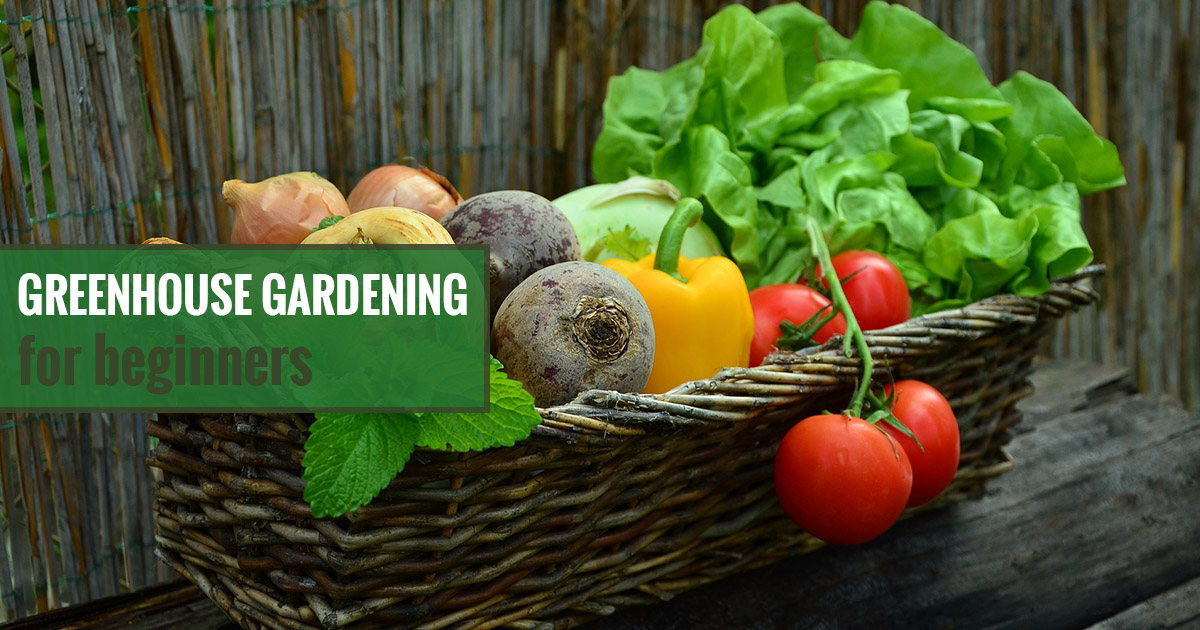
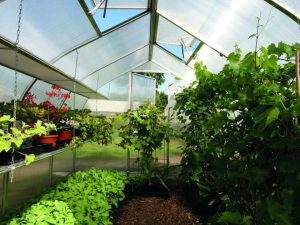























41 comments
Thank you for telling me to start little with the seeds and just focus on keeping their record entries. My mother and I are really into gardening and we’re thinking of putting up a greenhouse on the empty lot we own next to our house. I’ll take note of your tips while we look for possible seed and compost suppliers.
I am a beginner wanting to try my hand at starting plants. Flowers mostly so I can afford a variety of plants for my flower beds.
I live in central California. I am looking for a good green house. can you recommend any green house vendor?
Hi Chitra, just check out our shop. We sell greenhouses. You can also request a call back so we can help you pick the right one.
thank you so much for well detailed information. Would like to start a greenhouse as we realized that we are not fully utilising our big yard and also to increase our income earnings.
Is it necessary to sterilize potting materials I’m reusing year after year? I’m referring to seed trays & larger pots that I pot-up in. Also, what about bringing potted plants into the greenhouse for the winter that have spent the summer outside? Is it best to store my planting materials in the greenhouse or someplace else, bringing them in when I need them?
Hi Connie! It is necessary to sterilize potting materials and tools at the end of each growing season. To skip this task may lead to unwanted fungus and other pathogens in your new crop the following season.
Some plants require a winter rest period, so it will depend on the plant if it should be brought indoors for winter. Before bringing any pot into the greenhouse, you should check the plant thoroughly for pests and diseases. You don’t want to spread these to your healthy greenhouse plants! Check for and remove insects, eggs, and any diseased looking material.
You can keep soil and other planting materials in your greenhouse. It is recommended to store these in a closed container, in an enclosure off the ground, and away from other herbicides/fertilizers.
We are building a greenhouse. My primary use is to over winter tropical plants like Hibiscus. Do you have tips on over wintering? I live in zone 8a in Texas. I just want the plants to survive.
Hi Dee! Most tropical plants will be in danger below 50°F. In zone 8a, there will be temperatures below this point. Placing the greenhouse in a very sunny location is a good idea, unless you also plan to use it in spring and summer. You will need a heater in your greenhouse during low temperatures or the plants will not stay warm enough to survive. Also be certain to seal the greenhouse well at the seams to prevent air leakage.
Hi Sharon! In most situations a thickness of 8mm twin-wall Polycarbonate will work fine. This will be the case in zone 7b and you may be able to use a thinner wall if you plan on heating throughout the cold season. Hope this helps!
DONIA
these instructions are the same for just succulents ans cactus?
Thanks for answeri ng
Hi Donia! Succulents and cacti have many of the same requirements. In general, they need six hours of light per day. They will have greater need for soil that is well draining as they will not tolerate wet conditions. A good idea is to research the climate where cacti and succulents are natives and duplicate those conditions. Good luck with your greenhouse gardening!
I live in IL northern part I think it is a zone 5 I have never grown in a green house before would like to extend my growing. Season. Is there any thing I should do or not do. Is there any books you would recommend to help me. Can I start with small plants instead of seads
Hello Karen!
Please review our how-to-grow-guides section concerning the extending of your growing season. There is a lot of information that can cover this topic. I believe this will be a good place to start. Enjoy the journey of greenhouse gardening.
i live in MN in zone 4a/4b. winter can be extreame. so even with a greenhouse my season is limited. is there anything i can do to extend it some?
Hello Duane!! There are several ways to help extend your growing season with your greenhouse. Insulation and heating are the two that come to mind. Before you think about heating the space, you should also think about how to stop existing heat from escaping. Consider creating an inner layer inside your greenhouse structure. A second layer beneath the glass or polycarbonate already in place (with an air gap in between) can keep the space warmer all winter long. Please review the provided link for more ways to insulate your greenhouse. cold frames
Hi there. I am planning on converting my old small motor home into a greenhouse leaving tin roof on but covering two sides with opaque plastic. Will this work?
Hi Pat! Yes, you are utilizing one of the golden rules of cost savings for gardening, use whatever material is available to you. However, with a tin roof ventilation, for heat control, is going to be key. Have a great day.